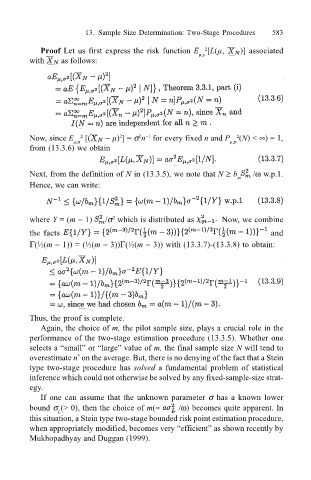Page 606 - Probability and Statistical Inference
P. 606
13. Sample Size Determination: Two-Stage Procedures 583
Proof Let us first express the risk function E µ,s 2 [L(µ, )] associated
with as follows:
2
2 −1
Now, since E µ,σ 2 [( − µ) ] = σ n for every fixed n and P µ,σ 2 (N) < ∞) = 1,
from (13.3.6) we obtain
Next, from the definition of N in (13.3.5), we note that N ≥ b /ω w.p.1.
m
Hence, we can write:
where Y = (m − 1) /σ which is distributed as Now, we combine
2
the facts and
Γ(½(m − 1)) = (½(m − 3))Γ(½(m − 3)) with (13.3.7)-(13.3.8) to obtain:
Thus, the proof is complete.
Again, the choice of m, the pilot sample size, plays a crucial role in the
performance of the two-stage estimation procedure (13.3.5). Whether one
selects a small or large value of m, the final sample size N will tend to
*
overestimate n on the average. But, there is no denying of the fact that a Stein
type two-stage procedure has solved a fundamental problem of statistical
inference which could not otherwise be solved by any fixed-sample-size strat-
egy.
If one can assume that the unknown parameter σ has a known lower
bound σ (> 0), then the choice of m(≈ /ω) becomes quite apparent. In
L
this situation, a Stein type two-stage bounded risk point estimation procedure,
when appropriately modified, becomes very efficient as shown recently by
Mukhopadhyay and Duggan (1999).

